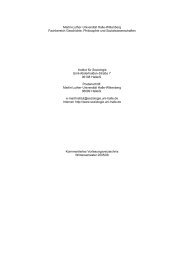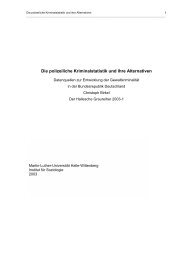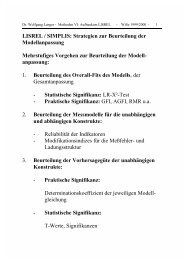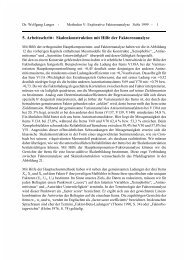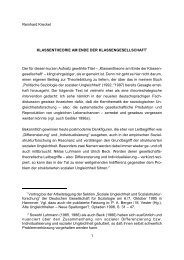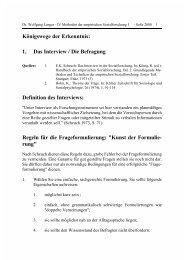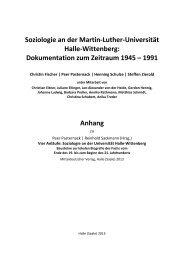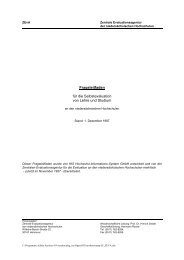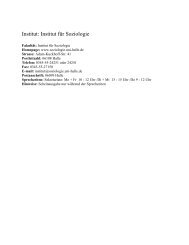EXPLAINING SOCIAL EXCLUSION - Institut für Soziologie
EXPLAINING SOCIAL EXCLUSION - Institut für Soziologie
EXPLAINING SOCIAL EXCLUSION - Institut für Soziologie
You also want an ePaper? Increase the reach of your titles
YUMPU automatically turns print PDFs into web optimized ePapers that Google loves.
International Journal of Sociology and Social Policy 96<br />
mobility in individual careers (Kalleberg and S0rensen 1979). Processes<br />
of individual careers are embedded in a structural process of social<br />
change. An understanding of the macro-social transformation is<br />
important for the explanation of individual mobility. This especially<br />
holds true in the case of accelerated social change e.g. in countries of<br />
transition from a communist economy to a market economy. One advantage<br />
of event-history analysis is that it allows a dynamic analysis of<br />
macro-social processes and individual processes, thus differentiating<br />
micro- and macro-level causation (Biossfeld and Rohwer 1995).<br />
Three possible effects of the structural components of the transition<br />
process on individual mobility are important. A first thesis is on<br />
the general direction of structural change of mobility due to the transition<br />
process. Some theoreticians of the transition suggested a general<br />
trend of downward mobility in East Germany. Like the Mezzogiorno<br />
in Italy, peripheral East Germany loses its own economic potential;<br />
general downward mobility therefore prevails. Contrary to this, modernisation<br />
theory suggests a modernisation vis a vis the backwardness<br />
of the communist economic structure. Especially the modemising<br />
trend towards more employment in the tertiary sector is supposed to be<br />
accompanied by more upward mobility (Zapf 1994; Biossfeld 1989).<br />
Hypothesis five is: a general rise of employment in the tertiary sector<br />
causes more individual upward mobility.<br />
A further thesis refers to the effect of the general level of unemployment<br />
on mobility. One could argue that during periods of recession<br />
the number of involuntary exits rises, forcing people to leave Jobs.<br />
Thus higher unemployment levels would lead to higher mobility levels.<br />
Contrary to this, one Suggestion is that a rise of the general level of<br />
unemployment causes a higher risk in mobility moves (Schettkat<br />
1992; DiPrete and Nonnemaker 1997). Therefore, the overall level of<br />
mobility is lower in times of high unemployment than in times of labour<br />
shortage, when there is more incentive and less risk to move between<br />
Jobs. Hypothesis six is: a general rise of unemployment reduces<br />
individual mobility.<br />
Volume 21 Number 4/5/6 2001 97<br />
A last thesis refers to the connection between structural and organisational<br />
change. As evolutionary Organisation theory suggests<br />
(Hannan and Carroll 1992), social mobility is more likely after new<br />
companies have been formed and old companies have been closed than<br />
after the enlargement and shrinkage of established companies. Haveman<br />
and Cohen (1994) showed that in the banking sector of California<br />
a growing number of Company formations, mergers and closures<br />
caused a higher rate of social mobility of employees. Especially the<br />
quick privatisation policy (Pickel and Wiesenthal 1997) of the East<br />
German transformation (with high rates of firm formations and firm<br />
closures) could have caused more social mobility during this period.<br />
Hypothesis seven is: a general rise offormation of companies raises<br />
the likelihood of upward mobility, whereas a general rise ofclosure of<br />
companies raises the likelihood of downward mobility.<br />
The following event-history analysis focusses on these seven<br />
hypotheses. To reduce the risk of a maladjusted model, we controlled<br />
for a number of variables: labour force experience; occupational prestige<br />
of current Job; gender; children; employment in the public sector;<br />
entry-cohort; number of preceding employment history spells; and rriigration<br />
to West Germany. We will not comment on the results of these<br />
control-variables, which were discussed in other publications (Weymann,<br />
Sackmann and Wingens 1999).<br />
Results of the event history analysis<br />
The aim of our event-history analysis is to find out what the effect of<br />
unemployment on social mobility career transitions is. Young East<br />
Germans, who took their exams in 1985 and 1990, were observed until<br />
the middle of 1997. As unemployment did not exist in GDR the period<br />
"at risk" started in November 1989. As we did know the length of the<br />
employment spells before 1989, this information was used in the<br />
model thus avoiding "left censoring" (Guo 1993). A highly flexible<br />
piecewise constant exponential model with competing risks was used.<br />
The central idea of such a piecewise constant model is to split the process<br />
time axis into intervals and to allow a Variation of the constant between<br />
the intervals. The model allows to control approximately for the



